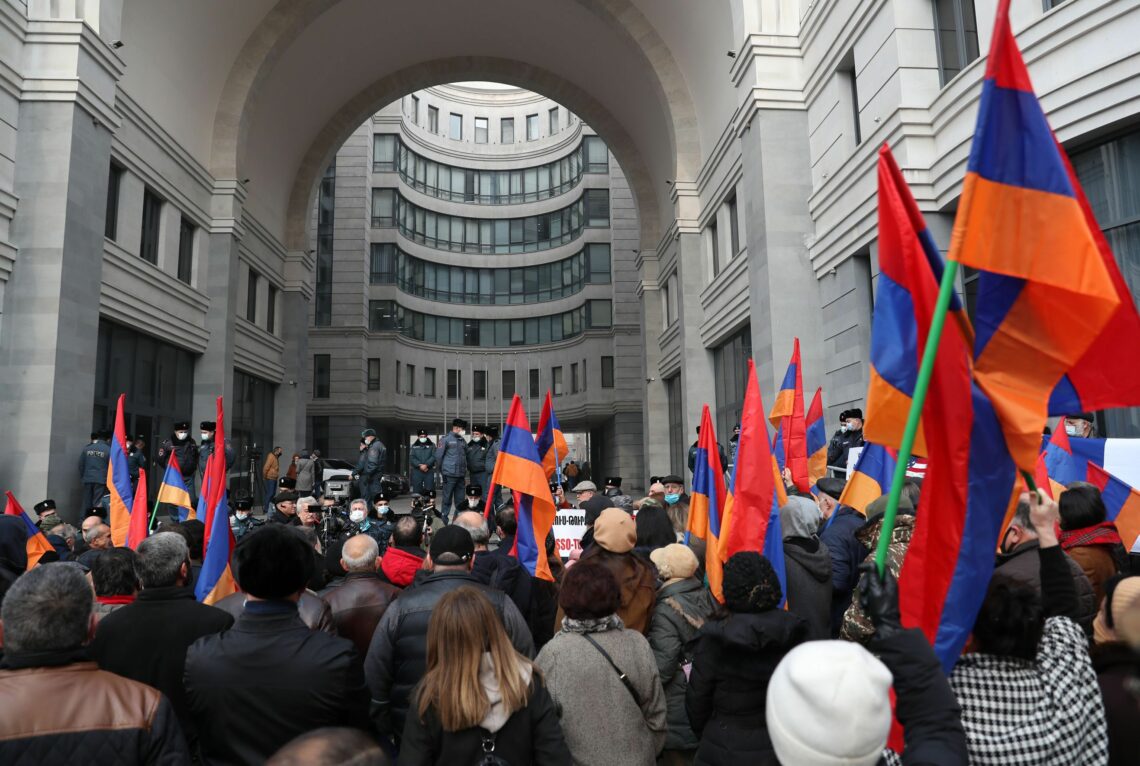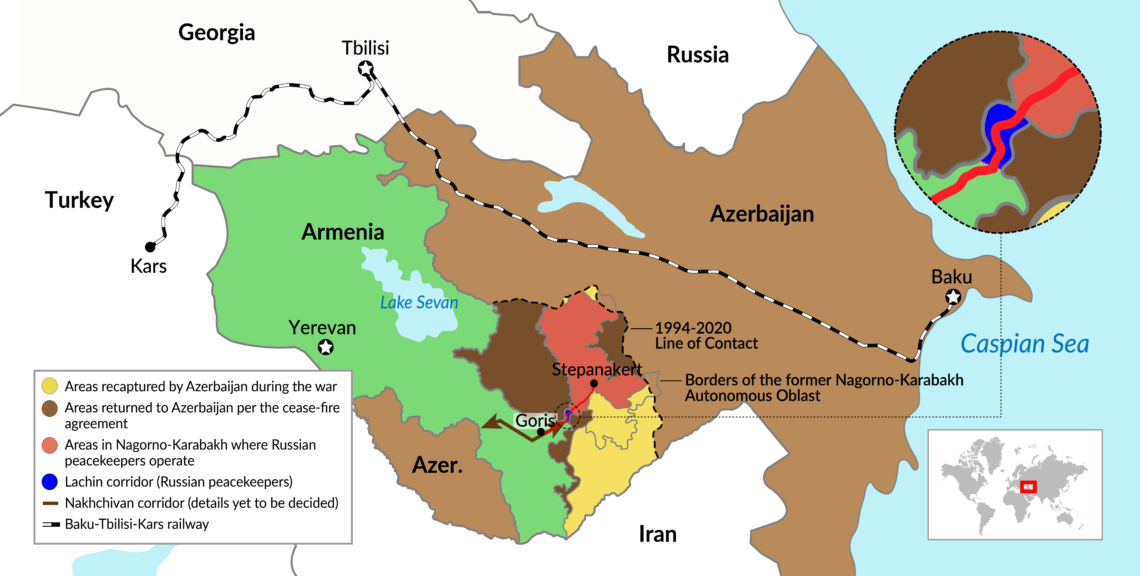The Nagorno-Karabakh war’s double tragedy for Armenia
The 44-day war between Azerbaijan and Armenia over the Nagorno-Karabakh region ended in a decisive victory for the former. The result has increased Armenia’s dependence on Moscow and stalled a crucial reform process initiated by Prime Minister Pashinyan.

In a nutshell
- Armenia was unprepared for its war with Azerbaijan
- Yerevan is now more dependent on Moscow than ever
- Reforming domestic institutions will be a struggle
Of all the various “frozen conflicts” scattered throughout the post-Soviet space, the Nagorno-Karabakh conflict between Armenia and Azerbaijan was the longest standing. Over the span of close to three decades, since a cease-fire in 1994, Russia had maintained a rough balance between the combatants, selling weapons to both sides. The six-week war in October-November 2020 brought that equilibrium to an abrupt end.
Armenia, convinced the conflict would remain a low-intensity trench war fought with outmoded weapons and tactics, was caught unprepared. Though it knew that Turkey had provided Azerbaijan with modern, high-tech arms, in the early stages of the war Yerevan remained confident it would prevail.
By November 10, when Russia managed to broker a halt to hostilities, Azerbaijan had recaptured some 80 percent of the total area that the 1994 cease-fire had left under Armenian control. For Armenia, the rout of its forces from Azeri territory was a double calamity. In addition to the military defeat and national humiliation, it also likely hindered the development of its social structures and institutions.
Facts & figures
Azerbaijan’s military goes high-tech
Prior to last year’s war, it was no secret that Azerbaijan had funneled much of its petrowealth into purchases of modern high-tech weaponry: Turkish Bayraktar TB2 combat drones that carry laser-guided bombs; Israeli reconnaissance and patrol Heron and Hermes unmanned aerial vehicles; and the Orbiter “kamikaze” drone, also made in Israel. When the Azeri forces launched their offensive in the Nagorno-Karabakh conflict, they showed that they had mastered state-of-the-art battle tactics that had been tested in Iraq, Syria and Libya.
Return of history
Political developments have become deeply intertwined with memories of historical injustices committed against the Armenian people. As anger and resentment over those injustices have risen, the government has tied its fortunes to appearing as a protector of the nation.
At the heart of the matter is the 1915 genocide, when Ottoman forces drove Armenians out of their traditional settlement area. Turkey’s rising prominence means the highly contentious question of that tragedy will again take center stage. Human rights defenders will join with the influential Armenian diaspora in calling on Western governments and the international community at large to label the events a genocide. These developments will further strain relations between Turkey and the West.
Artsakh was not recognized by any UN member state – even Armenia.
The Soviet Union made Nagorno-Karabakh, another large part of the traditional Armenian settlement area, an exclave within the Soviet Republic of Azerbaijan. With the war in 1988-1994, Armenian forces routed the Azeris from territories surrounding the exclave, ensuring that it was, de facto, joined with Armenia. Nagorno-Karabakh proclaimed independence as the Republic of Artsakh.
Artsakh was not recognized by any UN member state – even Armenia. Nor would the international community budge from its insistence that Armenian forces were illegally occupying Azeri land. With the help of Turkey, Azerbaijan has now regained control of the territories surrounding Nagorno-Karabakh, and the Republic of Artsakh has been reduced in size.
With Artsakh’s final status still to be decided, Armenia is faced with two hostile neighbors – Turkey and Azerbaijan – and with a Russian protector that has failed to live up to (perhaps unrealistic) expectations. The Kremlin’s obligations as part of the Collective Security Treaty Organization did not cover Armenian forces inside Azerbaijan. But the Armenians clearly saw the Russian military base in Gyumri as a sign that Moscow would protect it against a large-scale Azeri offensive.
Two corridors
Although the Russia-brokered cease-fire agreement saved Artsakh from being completely overrun, it also gave Yerevan some new headaches. As part of the settlement, two corridors will be introduced that further enhance Armenian vulnerability.
The first is known as the Nakhchivan corridor and will transverse Armenia’s southern Syunik province from the liberated territory in western Azerbaijan to the Nakhchivan Autonomous Republic, an Azeri exclave wedged in between Iran and Armenia. Baku is the biggest beneficiary of this new arrangement. For decades it has been dependent on Iran for transiting energy and other supplies to Nakhchivan. It will now gain direct access to its exclave.
Facts & figures

Turkey shares a 17-kilometer stretch of the southern border of Nakhchivan. Via this tiny sliver of land, Ankara now aims to build a direct route to Azerbaijan and onward to the Caspian Basin. In the longer term, it may even help Ankara strengthen its ties with Turkic peoples in Central Asia. The swift announcement by the Turkish government that it plans to build a railway through the corridor indicates prior strategic planning. Armenian territorial sovereignty will be compromised.
The second is the Lachin corridor, which contains the only road connecting Stepanakert, the de facto capital of the Nagorno-Karabakh region, with Armenia proper. With the Lachin District under Azerbaijani control, Russian peacekeepers have been placed in charge of ensuring that Armenia will have access to what remains of Artsakh.
Armenia is now more dependent on the Kremlin than ever before. The government of Armenian Prime Minister Nikol Pashinyan will have even less latitude to pursue a foreign policy seeking support from the European Union or the United States. His responsibility for the events that led up to the calamitous war is now the subject of intense focus.
Pashinyan’s problems
Mr. Pashinyan came to power in December 2018. He had called for a “velvet revolution” to rid the country of an oligarchic, nepotistic political system marked by pervasive corruption, close links between the ruling elite and a handful of oligarchs, and the concentration of power in the hands of a single political party. His message resonated with a younger generation frustrated by a lack of opportunities. His political coalition, the My Step Alliance, won a landslide 70 percent of the vote.
It was widely believed that the change in power would bring more than a breakthrough for liberal democracy and anti-corruption efforts. Many hoped it would also lead to rapprochement with the EU, a peaceful resolution to the Nagorno-Karabakh conflict and less dependence on Russia. Over the next two years, the enthusiasm withered, as the government became locked in bitter struggles with the opposition. Russia retained its grip, relations with the EU never significantly strengthened and war broke out with Azerbaijan.
Had Armenia negotiated a solution before the war, it might have created more leeway for reforms.
The Nagorno-Karabakh conflict was especially devastating for Armenia because the prospects for reform depended on the security situation in the region. If it had improved or held steady, the government would have earned enough political capital to push its agenda through. Since it has deteriorated, opposition to the government has strengthened.
Had Armenia and Azerbaijan negotiated a solution under the auspices of the Minsk Group, it might have created more leeway for reforms to gain traction. As things stand, the government has been crippled.
Military weakness
In its desire to score points at home, the Pashinyan government overplayed its hand. Taking a tough stance in relations with Azerbaijan, it discarded the “Basic Principles” that the Minsk Group had worked out as a format for a gradual political settlement.
Yerevan upped the ante by demanding that the unrecognized Republic of Artsakh be included in the discussions and that an agreement on its legal status be reached before the occupied territories could be returned. Even more brazenly, Mr. Pashinyan in effect called for annexation by declaring that Nagorno-Karabakh is part of Armenia. Defense Minister David Tonoyan even announced a new doctrine of seizing “new territories in the event of a new war.” Since Armenia had failed to modernize its military, this posture is even more remarkable.
Relying on outdated Russian-made arms and obsolete battle tactics, the Armenian defenders moved around in large groups and in flatbed trucks, and their artillery remained stationary for days. Faced with Azeri reconnaissance drones that helped pinpoint artillery strikes, they were sitting ducks. Armenian fighter jets remained grounded, and their Russian-made Osa and Strela antiaircraft missile systems were useless – the advanced planes that the Azeris used flew too high to be intercepted.
The Armenian side had failed to appreciate the seriousness of the new threat. As the Azeri combat drones, some of which operated from Turkey, began taking out tanks, missile systems, artillery and troops in wide trenches, Azerbaijan achieved not only military superiority but also profoundly demoralized the Armenian troops.
Polarized politics
The terms of the cease-fire that Armenia was forced to accept threw the country into an acute political crisis, bringing its long-standing polarization to the fore. A series of protests – some of which turned violent – has been ongoing in the country since the agreement was signed. Demonstrators are calling Mr. Pashinyan a “traitor” since his government lost territory that had played such a prominent in the country’s national identity. There are frequent calls for his resignation.
What may still save the government is the opposition’s trouble fielding a viable candidate to replace Prime Minister Pashinyan. President Armen Sargsyan has emerged as a key political player, taking a stand against the cease-fire agreement, calling on the government to resign and even making a “private” visit to Moscow. But he stopped short of presenting himself as a candidate. The opposition proposed the formation of a caretaker government, tasked with holding new parliamentary elections, but its candidate for prime minister, Vazgen Manukyan, is a deeply polarizing figure.
Scenarios
As long as Mr. Pashinyan retains the support of the My Step Alliance in parliament, his government will be safe. But this still leaves the question of the much-needed reform process.
When the war started, Armenia had already taken big steps toward reforming government structures and fighting corruption. Key figures of the former elite were dismissed from positions of power, charges were brought against officials involved in embezzling public funds and several of the monopolies that had supported the previous regime were broken up. Still, many critical reforms remained unimplemented, notably of the judiciary and the tax system.
Prospects are dim that the reform process will start up again soon. The level of political recrimination following the Nagorno-Karabakh conflict makes it nearly impossible. Perhaps most importantly, the future of the social order in Armenia will remain hostage to the unresolved issue of Artsakh. And in this crucial matter, Western governments will have to face the fact that their trains have now left the station. The Kremlin will be calling the shots.







